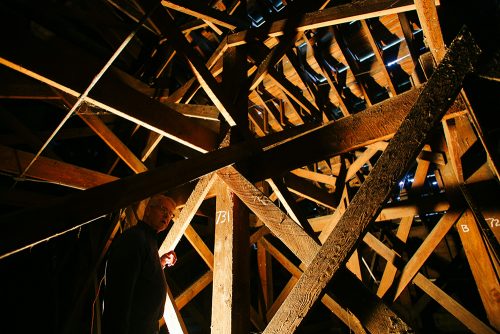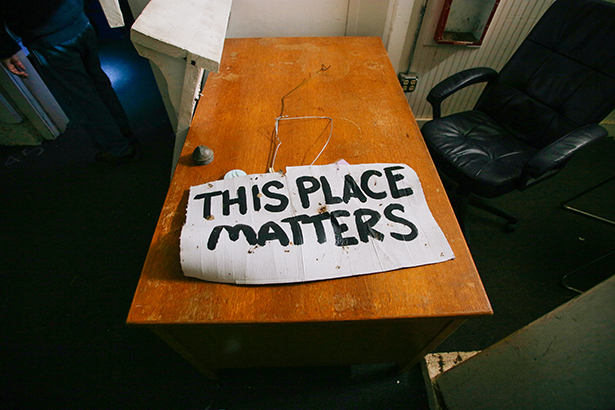
Eighty-eight-year-old Greg Giustina says he can remember attending World War II bond rallies at Civic Stadium in the 1940s. “They would bring war heroes to the field, and the early [bond] campaigns of the war would come through and speak,” Giustina says. “When you’re smaller, those things stick to you.”
At the time, bond rallies toured the country, racking up millions of dollars for the war effort and planting memories in the minds of children like Giustina, whose family was entwined with the building and use of Civic Stadium. Giustina Bros. Lumber Co. (now Giustina Resources) donated old-growth beams for the construction of the facility and sponsored the Giustina Reds, who played baseball at Civic in the Cascade League during the ’30s and ’40s, long before the Emeralds even formed.
Oregon remains a leading producer of lumber in the U.S., according to the U.S. Forest Service, and part of that legacy is built into the very structure of Civic Stadium. The place radiates Eugene history from every acre and wooden beam.
This intimate tie between Civic Stadium, the wood products industry and baseball has some wondering if a tribute to Lane County’s timber industry in the form of a museum on site might be appropriate.
As the old wooden building and its land moves into a new phase with 10.2 acres of property nearly in the middle of town, we now get to celebrate the multitude of options inherent to the site. How do we honor the history of Civic — from wood products to architecture to baseball — as we embrace the stadium’s bright new future as a venue for soccer and youth sports?
Out of the Depression
Nancy Webber with Eugene Civic Alliance says that she’s currently focused on closing the Civic deal with the city by March 30, but she has an eye on the future. “Even when there were difficult days, I would go home after working way too long and I would be excited about the possibilities of what could happen there,” she says of the Civic site.
Webber says historic preservation is an important piece of what the group will do, and figuring out ways to pay tribute to the site’s history is something that will likely happen when the group starts a series of meetings focused on the long-term strategic plan for the site.
Civic’s history goes back to the early 20th century, when the Giustina family started Giustina Bros., moving to Lane County in the early 1920s, according to a 1988 Register-Guard article about the family. The Giustinas and three other lumber companies donated timbers to help build Civic Stadium, a Depression-era Works Progress Administration project. George Giustina, the oldest of the company’s founders, was a big baseball fan and led his family’s involvement in the project.
“My grandfather’s older brother George was primarily involved in the volunteer program that donated lumber and got other people to donate to Civic Stadium, and that led to the sponsoring of the Giustina Reds,” says Dan Giustina, managing partner for Giustina Resources.
Joe Blakely, author of Eugene’s Civic Stadium, says it means “one heck of a lot” to see Civic Stadium saved and remembered. “I’ve never been so proud of anything in my whole life. Since I wrote [the book], it has just been so important in this effort, and I’m so happy with the way everything turned out.”
Historic recognition “is likely to be an assignment to a committee to develop further,” Webber says, and she lists Greg Ausland, an engineer for the project, and Linda Wheatley of the Eugene Parks Foundation as potential members of the committee.
Remember the Timbers
“I guess you could call the stadium itself part of a museum,” says Jon Anderson, president and publisher of Random Lengths, a publication that serves the wood products industry. “What I’ve been told is that you can still get underneath and see those beautiful old wooden beams, so you start with a museum right there, I suppose.”
“It’d be nice if the whole stadium site was going to be commemorative and honor the history,” Dan Giustina says. And the prospect of a wood products museum? “Personally, I would like to see that,” he says. “We’re in the business. There’s the World Forestry Center in Portland, but nothing close by, to my knowledge.”
Anderson of Random Lengths, a financial supporter of Civic’s restoration, expressed similar support. “If there’s room, that’d be a great idea,” Anderson says. “There’s not a museum to my knowledge in the Eugene area, and I think having something like that would be excellent.”
Anderson points out that the wood products industry continues to influence Lane County. “It has changed dramatically in my time, but it still plays a large role,” he says. “It’s still a big part of Lane County’s economy, and not just the mills but also the activities serving the mills, from insurance to equipment.”
a legacy of our own
Heather Kliever, registrar for the Lane County Historical Society and chair of the Eugene Historic Review Board, says the site at Civic Stadium and the structure itself represent a unique piece of Eugene’s history.
“You cannot build that again,” Kliever says, pointing out that the time during which we used old growth for buildings has passed. “Our environment can’t support it. It’s absolutely a gem.”
She says the preservation of Civic Stadium is a great opportunity for Eugeneans to embrace historic recognition. This hasn’t always happened in Eugene — see the pile of rubble that was once Eugene City Hall — but there are some great historic examples of Eugeneans coming together to save an important resource for future generations.
In 1937, Kliever says, a year before Civic Stadium was built, Spencer Butte was on the chopping block, slated for deforesting. Former Eugene Mayor F.M. Wilkins rallied the people of Eugene to purchase Spencer Butte and turn it into recreational land rather than clearcut it. Wilkins also brokered the deal for Hendricks Park, ensuring that some parkland existed in the residential area.
“Imagine Hendricks now if it had been completely built up,” Kliever says. “Eugene would be different. We would not be the same Eugene.”
 |
|
Sign found at Civic Stadium. Photo by Trask Bedortha.
|
In terms of recognizing the historical significance of the Civic Stadium spot, Kliever says that, for starters, history could be represented through heritage interpretation signs. “Maybe there could be some collaboration with historic groups in town,” she says. “There could even be noontime history lectures about the history of Amazon Creek, or talking about the history of baseball.”
And, like Anderson, Kliever points out that the stadium itself is a monument to the history of Lane County and its relationship with timber. “You just can’t go out and see trees like that anymore,” Kliever says. “We’ll probably never see that ever again in our lives. Dinosaurs among us — that’s what Civic is.”
Going the distance
“It’s a grand old place,” Greg Giustina says. He adds that he feels a bit detached from the stadium now, since his family played a role in Civic’s creation so long ago, but he also supports the interests of the community.
“I kind of go along with whatever the people here in town want,” he says. “And if they want to keep it, that’s just fine. You don’t know what the future holds. Down the way, if we got rid of it we might be sorry.”